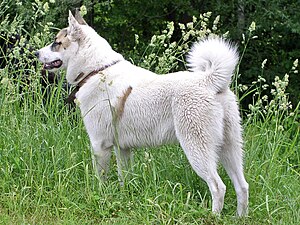Laika (dog breed)
| Laika | |||
|---|---|---|---|
|
|||
| FCI standard No. 304 to 306 | |||
|
|||
| Origin : | |||
| Alternative names: |
|
||
| Withers height: |
53-65 cm |
||
| Weight: |
21-30 kg |
||
| List of domestic dogs | |||
Under the name Laika ( Russian Лайка, Laika singular / Лайки, Laiki , plural ) are some Russian dog breeds , of which the FCI recognizes three and divides them into Group 5, Section 2 with the standard numbers 304, 305 and 306 .
The bitch Laika , who became known as the first living being in space as part of the Soviet space program, was not one of these breeds, despite her name.
Origin and meaning of the term “Laika” in Russian
The word Laika (Лайка) is from the verb Layat (лаять, barking) derived noun and literally means Beller .
description
The three breeds are very similar, they all grow to be around 65 cm tall and weigh up to 30 kg. Also within a breed they diverge as with many "working dogs", where the breed affiliation is of secondary importance, compared to the actual area of use. In 1947, the All- Union Cynology Congress in what was then the Soviet Union established standards for four Laika breeds, all of which are now recognized by the FCI . In addition to these standards, there are many regional breeds.
The following applies to all Laiki: thick fur with plenty of undercoat, fox-colored, gray-reddish, jackal-colored, wolf-colored, yellow, black / white. Standing ears set to the side and a rolled up tail.
Working method when hunting
Laiki are dogs that hunt independently and have the ability to have a strong bond with the handler. In accordance with their usefulness for hunting, they are assigned to the rove dogs , whose main task is to find, position and bark the prey independently. In contrast to the bracken , Laiki are usually not very loud . As soon as they have come close to the game on a driven hunt (e.g. in a thicket in contact with wild boar), they indicate this by barking loudly. A well-trained Laika does not drive the game in front of him, but circles it so that it remains in one place, which gives the hunter who comes up the chance to kill the piece. When browsing, Laiki typically use all of their senses equally, not just their nose. In contrast to the elkhound , a Laika usually doesn't rummage very far and seeks contact with the dog handler about every 20-30 minutes. After appropriate training, Laiki can also be used to search for game that has been shot - that is, was not immediately fatally hit and died.
Races in detail
Russian-European Laika
- This breed is common in the area from the Kola Peninsula to the Far East of Russia . The Russian-European Laika is closely related to the Karelian Bear Dog . It is the smallest of all recognized Laiki. The most common coloration in the breed is black with white markings. This Laika hit has now found its way to other European countries.
West Siberian Laika
- The main distribution area of the West Siberian Laika is the forest zone of the Urals , West Siberia and the lower Ob region . This breed is used in big game hunting.
East Siberian Laika
- This breed is the Laika of the open taiga area and Siberia . Due to the environmental conditions and its area of responsibility, this is the largest of the Laika breeds mentioned here. The most popular are monochrome, dark dogs.
Yakut laika
- Another Laika, provisionally recognized by the FCI in 2019.
Chukotskaja Jesdowaja, Chukchi-Laika
- In all of Siberia, all primitive dogs are descendants of the first dogs that immigrants from the south brought to these regions. Jesdowaja Laika means "transport laika" or "laika pulling a sledge":
Sources and further links
Individual evidence
- ↑ Zh. Zh. Barbot, Zhurnal Gramoty.ru (Ж. Ж. Варбот, ЖУРНАЛ ГРАМОТЫ.РУ): Origin of the word: Laika. March 31, 2014, accessed March 31, 2014 (Russian).
- ↑ Breed information from the Laika Club ( Memento of the original from February 24, 2009 in the Internet Archive ) Info: The archive link was inserted automatically and not yet checked. Please check the original and archive link according to the instructions and then remove this notice.
- ↑ a b H. Krebs, H. (conception), B. Hespeler (arrangement): Before and after the hunter test. 59th edition, blv, Munich 2012, ISBN 978-3-8354-1101-2 , p. 486.
- ↑ AT Woylochnikov, SD Woylochnikova (Анатолий Тихонович Войлочников, Светлана Дмитриевна Войлочникова): Die Jagdlaiki. ( Охотничьи лайки. ), Printed edition, p. 333: Elkhagd , [1] Lesnaya promyshlennost (Лесная промышленность), Moscow 1982. ( Russian )
- ↑ Breed standard No. 365 of the FCI: Laika (dog breed) (PDF)


